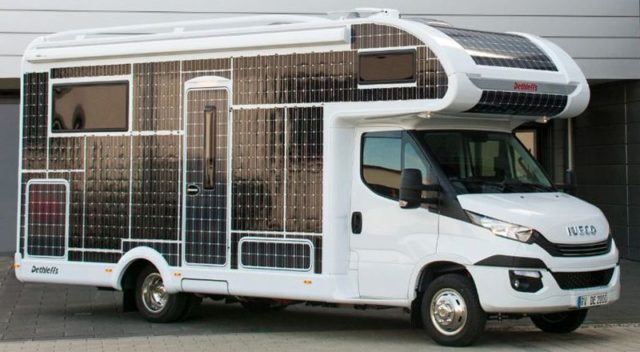
Imagine a trip around the country with no budget for fuel! Yes, this is possible now thanks to this impressive motorhome. The RV company Dethleffs has done something people couldn’t even dream of with this Iveco Daily Electric chassis. The car is perfectly capable of offering you off-grid status. There are solar panels installed, not only on the roof but on each side as well, in total 334 square feet of thin-film solar panels which can deliver up to 3,000 watts of energy. And you don’t even need a charging station!
The 228-Ah sodium-nickel-chloride battery, can get you, with all the fittings inside the RV just over 100 miles before letting it recharge. The battery should be good for approximately 1,500 charges or about 250,000 km. The RV is not only a house on wheels with some solar panels it is an actual e-home! It has driver assistance technology, smart windows and even an awesome system of heating that will literally make your life a whole lot easier, especially on the road. So this is the perfect vehicle for travelling around the country without worries!

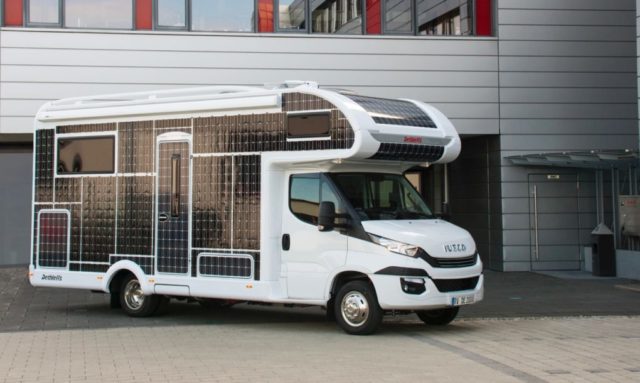
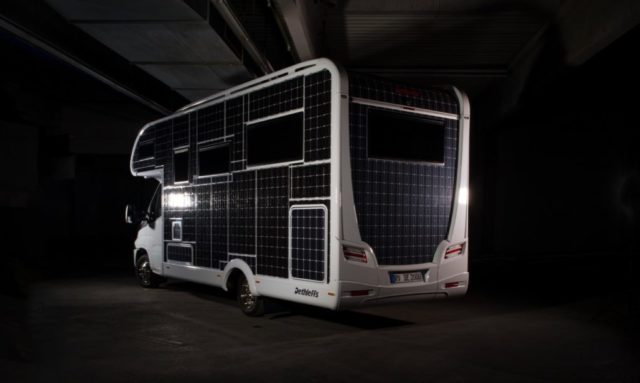

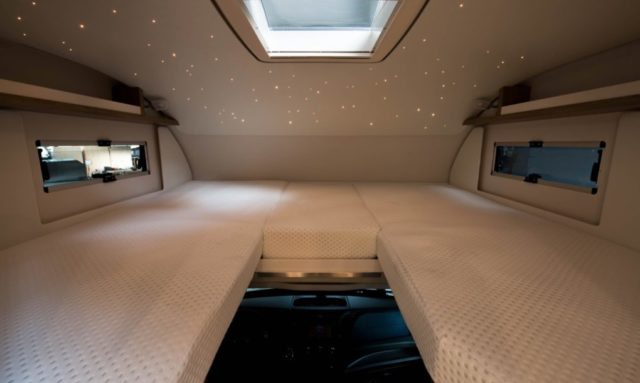 source: dethleffs.de
source: dethleffs.de

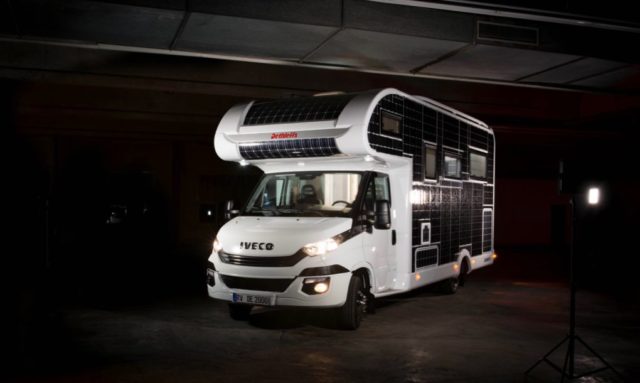

















What does this run and are there smaller/larger versions?
IT’s supposed to run on sunlight. It’s pretty small for an RV as is. The range is worthless. It’s certainly way overpriced.
That is what I want to know.
You wanted to know someone’s opinion, or facts?
How much solar power does it need to cook dinner? To heat your shower? To heat it in cold weather?
100 miles. WooHoo! I can get across the country in just over a month, as long as there’s enough sunlight and places to stop in sunlight and camp within 100 road miles of the previous location.
I’ll be impressed if they sell two.
What is the cost of unit shown? Seattle area
the range is only 100 miles? it’s not entirely clear.
Thats what I understand too from the article, 100 miles have to stop and charge? I dont think I want one.
If you are driving it in a cave then just shy of 100 miles. If you are driving it in full sunlight unlimited range.
Wrong. 3,000 watts is not enough to run a toaster and a light bulb, not to mention a vehicle of that size and weight. Without a charging station it would take 2 days to charge fully
Keep Dreaming. To fill a 225 Amp Battery, let’s say on 72 Volts, it takes 16,5 kw per hour. Now, the panels charge 3000 Watts, thus less than one fifth of this power one needs. If the car runs on 60-70% of battery energy, we need up to 12kw continuous. It will certainly help you to go further, possibly those 100 miles more, but at a normal continuous power surge, I doubt it will make i that 100 miles more. If we supply one fifth of the energy the battery needs to load, we probably make close to one fifth more distance with a battery charge, but only when the panels load full power. on the other side, if the panels are powerful enough to power the appliances, and load the battery, you can stop and take rest. In summer you stand anyway half time in highway files with longer forced pauses.
Driving would consume more power than was generated from the solar panels so not unlimited. In fact the panels only generate 3kW at most according to the article, so a full charge would take longer than a day. Your range would be 100km every two or even three days – gimmick!
I did additional research and the unlimited range I stated earlier is not true. This was false information some reporters have put out there. For some reason, the battery that drives the engine is not hooked up to the solar panels at all. You literally must plug in after less than a 100-mile range.
That not quite a true statement. You always have one drive battery hooked up to the motor and one charging. I need t sure why when something that can cut demand on fossil fuels that people start attacking it. The first cars in America was electric. Then, oil was found and money greed Corp as always start blocking and lying about any Competition.
No such thing as perpetual motion 🙂
Actually, that’s not accurate, Thomas. I went to the company website and read a bunch of other articles on this RV the first time I saw it. The range is 100 miles in the dark.
“The motorhome would have a range just shy of 100 miles if it wasn’t covered in solar panels, but it is. Those babies can make up to 3,000 watts of electricity for its 228-Ah battery. In other words, you’re all good to just keep on going.”
In other words, the power used to live won’t drain the battery used to drive. Put a Tesla Power Wall on it and, well, the possibilities are endless.
Hi Thomas sorry I didn’t see your update! And I didn’t even know the panels weren’t connected to the battery (??). I’m skeptical of this thing!
false/misleading advertisement…. The engine operates on a separate battery system. you have to charge it at charging station every 100 miles. Solar panels charge the interior lights, heater, stove, etc..
I’m very interested in this vehicle
Downside? Only 100 miles before it needs a recharge. Not much scenery to enjoy at 100 miles a whack. Plus, lack of recharging stations. None if doing remote rv’ing. I’ll pass.
it does not need recharging at a station, just let it sit in the sun.
How long does it take to recharge?: Article doesn’t say.
false/misleading advertisement…. The engine operates on a separate battery system. you have to charge it at charging station every 100 miles. Solar panels charge the interior lights, heater, stove, etc..
It’s solar, you don’t have to plug into electricity to recharge, all it needs is sunlight.
Exactly, 100 miles and batteries only good for 1500 charges. So 1500 miles and replacing how many batteries?
Tracy, this is what the article said. “The battery should be good for approximately 1,500 charges or about 250,000 km” 1500 charges x 100miles = 150,000 miles. still a short life though.
…that would be 150,000 miles.
150000 miles is more than any one will ever put on a motor home.
Tracy z, your math skills are amazing
wow your math skills need replacing.
1500 charges time 100 miles each is 150,000 miles. That being said, it will take more than a week to get from one end of California to the other. Also, the article doesnt say how long it takes to recharge. The tech just isnt there yet. Total novelty
It’s 150.000 miles to replace, see the math: 1500*100=150000
The idea is to recharge from the sun..
Yes, the range is limited to 100 miles on one full charge
I think it will be perfect for desert areas 😉
It’s just the first one. Give them time — it will get better.
Finally, a clear and calm mind!
Yeah and a regular RV gets what 10 mpg if you are lucky? @ $4.00 a gallon you won’t get very far either there luddite.
Well, my RV gets 12mpg and has a 35 gallon tank. So that means I will get over 400 miles on a tank. And my “recharge” takes less than 10 minutes. How log does it take to recharge the battery on that thing?
Duh- it’s SOLAR, covered with panels. Did you somehow miss that? It charges from the sun, so when the sun is out, it’s charging. The 100 miles is after sundown. And lack of charging stations? Seriously? SOLAR. Did you read any of this?
Do you really think you are moving a motorhome on 3000 watts? Also, the 3000 watts is MAX… probably the total rating of all the panels. In real life, you will get no where close to that.
And remember, at BEST, you’re only going to get a little more than 2/3rds of the panels with the sun hitting them, you’ll always have one side with no sun hitting it.
And the 2/3 is assuming you have the space to angle the vehicle so the sun hits the top, one side, and the back. Then of course you still won’t get full power out of those, because that depends on what angle the sun is shining on them!.
If you have to stop to charge anyway, might as well haul a big 24′ trailer too that has stacked racks on it, so when you park you can pull out some outrigger legs on four courners, then pull out slide racks on all four sides of the trailer that all have trays with solar panels in them.
Maybe even have moveable hinge pins so you could tilt the panels up in four directions, depending on where you put the hinge pins, get them all angled then plug in the wiring. (Would be too wearing/complicated to have it plugged in with the slides)
If you unhitched the trailer and moved the RV up a bit to give the trailer room, this would give you the 8×24 trailer size times 5. (yeah I know, not sure of panel sizes, but let’s pretend they fit perfectly for the point of this exercise, hehe)
Four slides plus the top center, so a total of 960 sq ft of solar space!
The trailers structural and mechanical setup would be awfully fun to design, lol. Designing the slides that would go out 24′ without flexing or bending, that’s gonna add some serious weight I bet!
Someone commented that the panels aren’t connected to the battery while driving, that is strange!! You’d think that charging while driving as well as regenerative braking would be a must!
Oh, throw in a gas generator with a big tank if you get stuck somewhere with no place to plug a charger in if it’s night or cloudy outside!!
I love the idea of an RV powered by electricity, but the reality is that it’s just going to be a play toy until they can get get batteries with a high enough energy density so that you could pack enough batteries in the RV to have a two or three day power reserve once they were all charged.
It’s like some of these “green” yachts they tout when selling, you can cruise soundlessly for a few hours before you have to fire up the engines again to recharge the batteries while you continue on, lol.
great start. load up a gasoline engine and make it a hybrid and they’ve got something till they perfect the technology.
Exactly. People hail these things as some amazing new technology that’s going to solve all our problems without knowing the first thing about the physics of it. And if you try to point this out, half the time you just get angry responses! Let them buy one and find out!
Philip, the battery that powers the engine is not run by the solar panels and needs recharging after 100 miles
But how long does it take to recharge? Also you have to have nice clear sunny skies to get a good charge, if it takes longer to charge up than to travel 100 miles then its going to take a long time to get anywhere. Also electric vehicles don’t do so well in cold climates so that further limits where you can travel too.
Its a detlef but this sounds to good to be thrue
Where can I get one?
Is there an inverter, or is it DC powered? What are “smart windows”?
Smart windows are windows that auto tint. Much like transitions glasses! The brighter it is, the darker the windows. 🙂
More than likely the drive motor or motors are polyphase (3 or more) variable frequency, variable voltage similar to motors used in electric or hybrid electric vehicles, elevators, electric ships, etc.
Battery storage is DC, which powers a DC bus. In addition to the variable freq. motor drive, there would be no reason a 110/220 VAC would not be used.
Surprised it does not have a built in charging station as a backup if the batteries are discharged and solar energy is not available due to weather.
If you consider the size and mass of the vehicle, 100 miles per charge is significant.
100 miles is significant, this is a great vehicle if your not in any hurry to get anywhere. Would be good for a retired couple or something. Could drive a couple hours, find a park, go sight seeing, come back, another couple of hours. I think the haters here are only thinking about if its practical for them.
Considering the size of the vehicle, it would take all day to charge, so you would go 100 miles, park, charge, sight see, do it again the next day. Sounds fun.
Could also use it for camping trips within 100-300 miles, would be nice to have full solar power once parked.
What is the strengths of the panels. Are they strong enough to with stand road debris hitting them?
Cost and availability in the US
Only 100 miles before recharge is needed doesn’t work very well. Usually over that daily. Most figure 300 miles a day when traveling
Well, it’s covered with solar panels… so isn’t it constantly charging while the sun is out? I think the 100 miles means once the sun goes down. Duh.
Dears,
1-can we have some details about this vehicule’s performance please? i live in a country with a lot of up and down Hills (Lebanon)
2- two water tanks H/C or just one?
3- price excl. taxes for export
I would like to know more.
intérêt
Where can I purchase one what are the price ranges
I would like more info please
on the outside it looks like it needs curtains…but great idea
This is a total gimmick. The solar panels can’t be in a good position to work to the maximum all the time. In countries with strong sunlight, at least 50% of the panels will be in shade at any given time.
Everything in the vehicle pulls electricity – the lighting, the heating etc.
You need 3000 watts just to boil a kettle!
Magnetic induction kettles and stovetop? LED lighting. Solar concentrator/IR LED ovens. If this isn’t a scam, I’m imagining they are utilizing all the high efficiency off-grid tech they can.
i think no no i know your right you can buy almost anything these days it all comes down to money i think at the end of the day waste of time looking for me but it,s defo the future and way to go
Luddite.
What kettle takes 3000 watts to boil? absolute nonsense.
“The average kettle holds 1.5 litres of water and uses about 0.1 kWh of electricity to boil for 3 minutes.”
How much?
What do these go for?
Would be absolutely wonderful, I’m just not sure how the panels would go with stones being flicked up by passing cars….Brilliant concept though.
Were can I get it?
Please send more info and cost details Please?
What does this cost and where can I get one?
Where is this being sold? Can it be custom ordered? As shown, what is the ticket price? Thanks .
How much? Available in Canada?
100 miles won’t even get me to the lake. I will also lay odds that it can’t pull even a single axle boat or motorcycle trailer. Nice concept – no practical application.
Hello,
I have always wanted to drive across North America.
If you would like someone to provide publicity and promo your RV please let me know.
I would be really interested if you would be will to provide some sort of deal.
Please let me know.
Thank you,
Tracy Bolduc
Really cool, but the numbers given don’t add up. The solar would be useful, but it’s not enough to eliminate charging, unless you’re willing to stop for several days every 100 miles.
What about second motor and price? Is it available? 3000 W.. Is it enough for powering the vehicle??
Been living in my Mazda Proteje for 3 years & 8 months. Would LOVE to move into one of these… What is the price? How available are qualified mechanics, in case repairs are required, at some point? Are they available in the U.S.?
Definitely interested!
Only 100 miles per recharge you all say? Maybe so at night but during daylight it is continuously recharging. Wake up at dawn for breakfast and by the time you finish it has been recharged even on a cloudy day. 500 watts is good for a car, 3kW is around 2000 horses, so more than enough.
You will only get 3000w if ALL the solar panels were aimed directly at the sun on a cloudless day at once. Since the sun can’t shine on all 4 sides at once, you will be getting somewhere around 1000w at best. And better check your math. 3kw is very close to 4hp (746w/hp).
Where can I get one?
3000W is most of a thirty amp RV pedestal service so it would be enough to run one rooftop AC when parked, or to run a space heater and a microwave. The batteries would be current leveling, as electrical loads would routinely spike to excess of panel capacity, however if there’s enough battery to move the whole rig 100 miles, then running a heater at night shouldn’t be a problem. Also, in the USA, if this thing has a standard charging port (like a Tesla or a Leaf etc..) then there are many places to charge it and it would only take a couple of hours. That’s still not a great many miles per day but hey, what do you want when saving a thousand dollars in fuel on a longer trip? I can get a lot of touristy stuff done with that extra grand while this puppy charges itself in the sun.
Sign me up!
What is the cost? Not mentioned in article.
You would still have to charge it. 3000 watts is just 4 horsepower, but the solarpanels could extend it’s driving range a little bit. The article smells a little like clickbait.
I would like to know more about this ride i would really like to have one or more
Over 3000 watts sounds great, but do the math and you’re talking 4 horsepower.
Is this available in Montreal Canada?
Great idea, however I would prefer a backup of plug in and an on board engine generating backup…like my own system with fold out panels, you often rotate your vehicle to get the best sun if you nee
d too…I like its looks too….Price I am sure will be in excess of $150.000..
Looking to help promote, I think this is going to be the future.
WHERE CAN I PURCHASE THIS AND HOW MUCH DOES IT COST ??? I AM VERY MUCH INTERESTED
I’d like to self promo it as well. What’s the possibility of this?
A magnificent concept and I wish it every success.
The unspoken facts are that with this system you’ll get about 100 miles every 5-9 days depending on light levels and power use while you’re waiting.
At once point I wanted to design a cheap solar powered van for homeless people. I was gonna strip out the whole power train and add a basic battery system, solar and 48v motor.
A couple hours of math later and I had figured out that rooftop solar you would get about 5 miles a day of power doing less than 25 miles per hour.
I figured I’d be able to take junk vans and for about $700 make them moving homes with beds, water, toilets with a max range of about 35-50 miles per charge at a max speed of 25 mph.
After seeing the limits I checked about adding a $200 generator and one could keep going (still max 25 mph)… in the end I wasn’t sure that people would actually want this.
Yes, 100 miles on a charge, plus whatever charges collected during that 100 miles, plus whatever charge is collected from deceleration/breaking.
if the company tried doing a small partnership with Tesla, putting a larger battery in the vehicle oh, they might be better off. There are costs involved and the size of the battery might be a cost for the.
Yes i wouks definatly have a built in gas or deasil gemerator for hybrid operatiom. You donr want to get stranded.
Really interested
Would promote in Indian country and the southwest
Fantastic!
More details, please. Price, availability, warranty, etc.
I’m interested
It’s just a prototype. The company says they have no plans to produce or sell it. They simply want to put the idea out there.
Love how they specify the solar array’s capacity in watts and the battery in Ahr so you can’t figure out how long it takes to charge that 100 mile pack. My guess is many days. The numbers don’t work very well powering a vehicle with vehicle mounted solar cells. Give us the voltage of that 228Ahr pack, otherwise there’s no way to know.
I need one of these!
How many MPH? I’d be pretty frustrated if it went 20mph.
I wish manufacturers in North America would take a lesson from European designed RVs (or caravans as they’re called in some places). Not all of us even WANT these huge monstrosities! How about a nice compact unit with all the necessary amenities with a much smaller footprint? I mean, if we can ‘dream’ small house plans, why not RVs? Get real please!
There is actually someone who converted a VW Camper to solar electric power. The same guy is also part of a team that solar powered a larger van converted to a motor home. Both designs are better thought out than this one…the panels lie horizontal, but when the vehicle is stopped, they can be tilted and/or expanded to catch maximum sunlight. But they have serious limitations. The VW camper version will cost you about $120,000, the larger van much more. The speed is limited…the big van’s max speed is about 50 mph. It could go faster, but air drag starts to impact range at higher speeds. The range is short, 100 miles or less on a charge. The time to recharge depends on the sun, of course, but in good conditions, the VW recharges in a day, the big van in about 3 days. The idea is not speed, but sightseeing slowly…move a little, stay a few days and explore, get your charge, then move a little more. Repeat. They are trying to drive the large camper van all the way from the Yukon down the west coast to the tip of South America. See these videos: youtube.com/watch?v=fGZ1zbqAGA0 and youtube.com/watch?v=pcj2lQwH7N4
Remarks say runs only for 100 miles. If it’s solar charged why does it only run for 100 miles?
Motors consume 30+kw/h (conservative, probably more), solar panels only generate 3kw/h (max output, reality maybe 1.5kw), the other 27 (29) come from the battery.
Because math. The solar array is nowhere near large enough to power the vehicle all by itself. The battery discharges at a high rate to power the van for 100 miles. Then it is empty and you have to either plug it in to recharge, or wait for the panels to slowly recharge the battery…which, given the type of cells, their orientation, and the panel sizes, will probably take about a week. (The panels do help some during travel, but not nearly enough to keep up with the demand.)
Why not put a Li-Ion power cell in and get some real mileage range.
Beautiful and makes total sense!
Chris
Smart vehicle? No thanks. This means it is a rolling antenna for wireless radiation. I can roll down my own windows and use my hands to turn up or down heat. I don’t need WIFI to do that for me and I prefer not to be exposed to high levels of RF in a metal box.
Interested in price and availability in USA.
Are there back-up plug ports for charging?
# and size of water tanks.
Additional engine cooling systems?
Availability of washer/dryer options.
Refrigeration options?
Propane range/oven options?
Master bedroom in rear?
Storage options?
Need more info!!!
Is it me or does something look off with the photos? The interior shots of the RV don’t seem to match the exterior photos especially where the door is or should be. Also having all those solar panels on the side will not do too much when there is not direct light hitting the sides. To me it almost seems like somebody photoshopped solar panels on the sides of it. But that’s just my thought on this.
You’ll need to explain to people the difference in efficiency between cloudy and sunny days. Will the total trip be extended if the sun is out (the battery charges while driving)? On a cloudy day does that mean if the battery runs out you park it and you’re done for the day? Is there a backup generator? Is there regenerative braking? Can this become an ‘electric assisted’ vehicle as well? I love the idea but it’s … vague.
How much?
The 100 mile range would only apply at night. During the day the solar panels will be continuously recharging the batteries. There will be a lot of amps going into the batteries, even if one side is shaded and even if the day is overcast. Full sun on all the panels (a condition that will never apply) would yield 250 amps at 12 volts. Even 2/3 of that (accounting for the one side and maybe back that are in shade) is a significant amount of juice. Without know what the electric motor consumes it’s hard to say how far it will get you.
How many does it sit/sleep?
Where can I get make, available models, specifications for each and pricing for vehicles such as this.
No such information was provided in the advertisement here.
It’s a CONCEPT. That means you can’t buy one. If you could, you’d find the price was astronomical and the performance way below what most people would accept. The only solar powered motorhome I’ve seen actually running uses about this much panel area, but in three horizontal panels. Only one sees the sun while the van is in motion, the others are deployed when you stop, and the whole mess tilted to get the most sun. I think this experimental project cost in the neighborhood of a quarter million dollars.
People need to learn to do some basic arithmetic. You can get maybe 600-700 watts of panels on the roof of a full size van. Let’s say you carry two additional arrays of the same size, total is now 2100 watts, max. You get about four hours of full sun per day. Let’s be generous and say 6. That’s 2100 x 6 = 12.6 kWh. The battery of a Tesla 3 is 7.7 kWh, so (neglecting losses, which we shouldn’t) your panels can charge the equivalent of 1.64 Tesla 3 batteries per day. Our van is big and heavy and draggy, so it probably doesn’t get any more range than the Tesla 3, or 310 miles. But remember, we had to be sitting still to deploy all our panels and get this charge. While driving, we only have 700 x 6 = 4.2 kWh per day from our single array. So…we can go maybe 450 miles on a full charge, plus what we got from the sun while moving. Then we have to stop and charge up another full day. And this is not counting a whole bunch of losses and inefficiencies. Fully solar powered, grid-free vehicles are a wonderful idea, but they are not there yet.
Where can I get make, available models, specifications for each and pricing for vehicles such as this.
No such information was provided in the advertisement here.
The future is here while fossil fuels are nearing the end of availability.
The future belongs to electric vehicles, self powed like this truck of by personal solar generators.
Michael Atchia
Just over 100 miles?!? That’s hardly enough to get out of the city limits! ….and is that 100 miles during the day in the sun on flat land? There are so many unanswered questions, it makes it sound like a bad product. Give ALL the details and specifications.
What if you run out of juice at night in the middle of nowhere? Is there a way to get an emergency charge? ….like from a generator?
Sounds like a nightmare…..
Rod
Let’s do some quick calculations. With 3,000 kw of solar panels, if all of them are oriented properly (impossible in this case, but I’ll ignore that), will produce a max of around 25kwh of energy per day assuming it’s sunny. That’s absolute best case scenario. A vehicle like this will probably require at least twice the energy of a Tesla due to size and weight, but let’s be generous and say 50% more, so about 600 watts per mile. The farthest you could travel per day on solar is 42 miles per day, assuming you don’t use ac, lights, or cooking when parked.
Realistically it’s probably less than 25. Neat idea, but manage your expectations.
Without specifying a voltage, this 228-Amp Hour statistic has no meaning.
For reference, a Tesla battery has 60,000 to 85,000 kwh, and takes overnight to charge. These solar cells do not have anywhere near that capacity. However, the electric system is probably adequate to power lights, a TV and a microwave.
If it sounds to good to be true — in this case — it is.
I would be interested in learning more, please direct me to a website where I could find out details and prices.
watch the video guys
Solar panels only support interior appliances, not the engine. This baby still runs on gas
To be fair the article pretty much states that the entire RV is solar powered. This line right here actually.
“The 228-Ah sodium-nickel-chloride battery, can get you, with all the fittings inside the RV just over 100 miles before letting it recharge.”
The folks who wrote the article couldn’t even get the information correct.
It’s a novel idea. A waste of time and money but a novel idea none the less.
as for the cost… if ya have to ask, it’s too much. this is cost-no-object.
3000 watts = 4 hp. That’s enough to run a lawnmower, but not a heavy RV.
How much and where can I buy it?
Could they design a recharging system that recharges while driving like those in hybrid vehicles to travel farther on a charge?
I’ll immediately grab your rss feed as I can not
in finding your e-mail subscription link or newsletter service.
Do you’ve any? Please permit me know so that I may subscribe.
Thanks.
Way cool! Some extremely valid points! I appreciate you penning this article and the
rest of the website is very good.
How much is the unit?
I am in fact happy to glance at this website posts which includes lots of valuable
facts, thanks for providing these kinds of information.
How much is this and where can I go to see one or purchase one?
Is it a one off or is it in production / available for purchase? Is it a hybrid (gas and sunlight) or just sunlight?
“Imagine a trip around the country with no budget for fuel”
100 miles a day (1 1/2 hrs), then charge
Charging time based on 50kW batteries system and 3kW Solar Panels
Only roof and one side in the sun at a time so
Reality 1kw capacity, 12 hours day, 12kw/day, 4 days to recharge
Travel 100 miles every 4 days.
Travel from LA to NY in only 112 days one way…if everything is perfect.
7.5 months round trip – 1 month vacation time, 6.52 month LoA
$0.00 budgeted for fuel, 6.5 months leave of absence. wage loss $26,000
Drive for 5 days, enjoy 20 days of vacation time, drive for 5 days, return to work.
10 miles/gallon, 560 gallons, Fuel cost 560 X $2.50 gallon = $1400
All that sun to charge it and a/c on the roof. This one won’t do well in Florida. 🙁 BUT, I love the idea for other locales!!!
If you had two batteries could you be charging one while using the other? That way you don’t need to stop?
Either the reporter for this story is paid by opec, or the range and charge cycle number is under par. 100 miles won’t cut it.
How much does one cost? More information please.
So once you’ve purchased this, at a no doubt exorbitant price, and driven it for 250,000 miles, (not unusual for the RV lifestyle) 100 MILES AT A TIME, how much is this super high tech battery going to cost to replace?
I think that there is a safety issue.
If you are driving next to RV the sun reflecting off the solar panels could blind a driver suddenly! If you are sitting on the sunny side it could hot..waiting for the battery to charge.
Are these sold in Australia yet? What’s the price currently? How can you get hold of a broshure? I sent a message to Germany about a year ago and got no reply?
I had two solar panels installed on the roof of my Pleasureway van. All they need are daylight to charge or driving. One additional battery was added to the two coach batteries it cane with. Could sit five days w/out electricity before needing to be driven to charge up.
Its a study from 2017: At the Caravan Salon in Dethleffs is the first manufacturer to present a fully electric motorhome as a study. Source: dethleffs.co.uk/the-company/history/
I will keep my diesel RV, 30 gallon tank at 65 mph takes me 300 plus miles then I can refill my tank in five minutes and drive another 300 miles in one day if I choose to. A new oil field in Texas is largest fined in the world about 300 year supply @ 2.43 to 2.89 a gallon. And I can drive all of those miles at night and run everything AC, heater, microwave, coffee pot, satellite system, two TVs, residential frig, and lights 24/7. Like I said I will keep my diesel RV.
That’s 150,000 miles
I would like to know the price and availability.
These solar panels at full sunlight is like charging on a 15amp outlet.
The question never answered… how long does it take to have the solar recharge the battery? My guess would be “days”.
OMG I love this! I drew plans for something like this. Very similar to this, (a bit more play room for kids)!!!! How much?
I love to travel and do trade shows. I am at Quartzite and other happenings around the USA yearly. Do you need someone knowledgeable in solar power and RVing to travel the USA and promote your product? If so contact me.
-David Green
LinkedIn: NetRangerrr
If you could switch to lithium batteries in the future it would probably go a whole lot further!
The question is: how long does a zero-to-full battery charge take? Im guessing about two weeks.
What if it rains for a week. Isn’t there electric backup ? Or generator? Something??
I would love to own one of these Rv if you don’t have to use gas
Where would you get one how much a fotune l bet
Yeah, if you just want to drive 99 miles to the desert and stay there all week. Anyone who has an RV or travel trailer will tell you that rarely is your trip just 100 miles. More often than not, you’re driving two to three times that mileage just getting to your destination. Not practical. Yet.
A rather large number of people who rv and pull travel trailers, prefer night driving because you beat all the traffic.
1500 recharges at a 100 miles a pop =1500×100=150000 miles
Not true folks. The guy said Solar Panels Are Not Hooked Up To Vehicle Battery! You have to physically hook it up when the charge is almost gone within the 100 miles! I would of liked it if you could drive 1,000 or so miles a day & 100 at night. But it doesn’t. They need to have solar panels hooked up to batteries. This would of been perfect for my trip but not at 100 miles at a time. And how long does it take to get a full charge?
Yeah it doesnt mention the charging time for solar only….I’m sure it has a plug in option too. At least it should….I’d guess it takes almost 2 full days of it sitting in the sun for it to get that 100 miles on solar. Being that the panels are on the side it’s not the most efficient way to take the sun in, one side will always be in shade. Also the hundred miles is probably, empty, slightly downhill with a stiff breeze to your back lol
Nobody has ask the one thing I want to know.
How long does it take to charge from dead to full.
Is there a warning so you can find somewhere to park, not just dead on the road side.
$4.00 a gallon? Where are you from? At its highes it barely got above$3.00 in Missouri! But i do agree they are extremely expensive to drive because of the poor fuel mileage
I want one what does it cost and how can I get one a rechargeable RV running on solar energy sweet
$4 a gallon? I’m paying $1.90. Where do you live? Cali?
I wonder how it will stand up to hail that would be pelting it on all sides
How much does one cost and where can I purchase it?
I want one
More info please
while you’re saying duh as if we’re stupid for the whole texting conversation did you miss the point where it says batteries do not charge to the solar panels and the batteries are only good for a hundred miles more than likely due to the weight and the said power to move such a vehicle okay it’s only good for a hundred f****** miles duh DUH
funny thing is while this little online argument is going on about chargeable and solar panel on the bed this is a tremendous state-of-the-art SUV that off the grid solar power okay well all of us are having this argument how many of us can realistically even begin to dream of having this I know I personally cannot yet here I am still arguing over a battery I find it, call the things that will argue about online they don’t even pertain to us other than curiosity factor. Human nature I suppose to be curious and to.
and while we’re having this online argument over a hundred mile battery life and would it be more expensive than gas in the recharging indebted if you have a woman with you you’re going to stop every hundred f****** miles anyway so what’s it matter so that’s how that is and if you have a vehicle like that and don’t have a woman with you where you got your dog with you and they’re going to need to pay at least over a hundred miles so you didn’t stop anyway so what’s the big deal. truly does anyone think of these things some of these things that are just common sense or kind of overlooked we create them as big huge problems when really they’re not a problem at all because you’re going to have to do this or that anyway.
How much is the solar rv?
I doubt very much that the number of solar cells that vehicle could accommodate would charge the main battery in less than a week sitting in full sun. I haven’t watched the video or done any other research, but I bet the solar panels run the fans, radio, lights, etc, and the truck itself either runs on gas or is a PHEV (plug in hybrid), where you plug it in and the gas engine takes over when the battery is exhausted, The solar cells might contribute to the charge, but not much. This is certainly NOT a fuel-free motorhome.
Nice try, though. Just imagine the repair costs of the smallest fender bender! No insurance company will touch it.
Would get about 10miles in uk them never work again with our sunlight
I saw in Hawaii a guy replaced engine on his petrol vehicle with electric motor. I want one
Yeah, you’ll save on fuel, but this thing costs the same as a nice home!
Sooo, does it have to be plugged in after 100 miles? If so, what are the solar panels dong if not being charged by the sun for natural power? And why aren’t they attached some how to the engine to make it run?
3000 watts is nowhere near enough to charge and drive with something that heavy. In full direct sun (on the side FACING the sun) it would likely take all day to charge enough to go the 100 miles.
This has been my retirement dream to e able to retire..selling my house soon. Very interested.
100 miles is plenty. I mean where you going? From the RV park to WalMart? Maby get crazy and go to Golden Corral? Hey, it’s your birthday let’s go to Cracker barrel.
Where can I get one of these RV?
At 228AHr, if the battery system is 12v, and the charging system was producing at max 3,000 watts, you would have a max charge rate if 250 amps. However, the full 3,000 watt solar output would be unlikely all of the time, and a 250 amp charge rate might not be best fir battery life. In any case, 100 mike range is about two hours, so the question of daily mileage is how many times you can recharge in solar per day, so how many two hour sprints you can do per day.
The estimated life of the batteries is about 150,000 mikes. If you’ve shopped for a used RV, you know that us far longer than most RVs are used by an original owner. More typical use by an original purchaser is 20,000 to 70,000 mikes. Only full timers or rental units typically are driven further.
Nothing a few tweaks cant fix
Says it has heating, but here air conditioning is equally or even more important. What about A/C? Say you kick up a rock or get a bb thorough a window. Will the rest of the system go out?
To self charge would take days.
Looks cool. How much ?
Wonder how much the battery is? Wonder if Tesla’s house battery could be used to power the rv while the panels are recharging? 2 or 3 house batteries connected to a small generator using the rvs motion to power the generator could create a perpetual energy loop?????